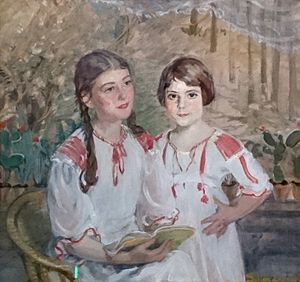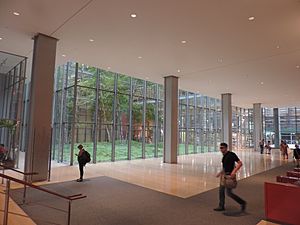Cornelia Oberlander facts for kids
Quick facts for kids
Cornelia Hahn Oberlander
CC OBC
|
|
|---|---|
 |
|
| Born |
Cornelia Hahn
20 June 1921 Muelheim-Ruhr, Rhine Province, Free State of Prussia, Weimar Republic
|
| Died | 22 May 2021 (aged 99) Vancouver, British Columbia, Canada
|
| Nationality | German, Canadian |
| Alma mater | Smith College, Harvard |
| Occupation | Architect |
| Awards | Order of Canada, American Society of Landscape Architects Medal, Sir Geoffrey Jellicoe Award, Governor General’s Medal in Landscape Architecture |
| Practice | Cornelia Hahn Oberlander Landscape Architects |
| Buildings | C. K. Choi Building, Vancouver Public Library, Northwest Territories Legislative Building, Canadian Chancery in Washington, D.C., National Gallery of Canada, Museum of Anthropology at UBC, Robson Square, and Vancouver Law Courts |
| Projects | Peacekeeping Monument, VanDusen Botanical Garden Visitors Center |
| Design | Canadian Government Pavilion, Children's Creative Centre and play area for Expo 67 in Montreal |
Cornelia Hahn Oberlander (born June 20, 1921 – died May 22, 2021) was a highly respected Canadian landscape architect. A landscape architect designs outdoor spaces like parks, gardens, and public areas. Cornelia founded her own company, Cornelia Hahn Oberlander Landscape Architects, in 1953. This was after she moved to Vancouver, Canada.
Throughout her long career, she helped design many important buildings and spaces. These include Robson Square and the Law Courts in Vancouver. She also worked on the National Gallery of Canada and the Canadian Embassy in Washington D.C.. Other notable projects include the Vancouver Public Library and the Museum of Anthropology at UBC. She even designed parts of the Northwest Territories Legislative Assembly Building in Yellowknife.
Contents
Cornelia's Early Life and Family History

Cornelia Oberlander was born in Muelheim-Ruhr, Germany, on June 20, 1921. Her mother, Beate Hahn, was a gardener who wrote children's books about plants. She taught Cornelia to love nature from a very young age. Cornelia remembered having her own garden bed at age four. She planted peas and corn, learning the joy of growing things.
When she was eleven, Cornelia saw a painting of a river and a town. She asked the artist about the green areas in the painting. The artist told her they were parks. Cornelia then told her mother, "I want to make parks!" From that moment, all her studies were aimed at becoming a landscape architect.
In 1938, when Cornelia was 18, her family faced danger because they were Jewish. They had to escape Germany to avoid persecution during the "Night of Broken Glass" (Kristallnacht). This was a terrible event where Jewish homes and businesses were attacked. Cornelia, her sister, and her mother first fled to England. Then, in 1939, they moved to the United States.
During World War II, Cornelia worked on her mother's farm in New Hampshire. She had come to America hoping to study how to create parks and green spaces. She worked hard to achieve this goal in American colleges.
Education and Professional Journey
In 1944, Cornelia earned her first degree from Smith College. Later, in 1947, she made history at Harvard Graduate School of Design. She was among the first group of women to earn a degree in landscape architecture from Harvard. She once said that before the war, women could not attend Harvard directly. But this changed, and she was one of the first women admitted to the design school in 1943.
At Harvard, she met her future husband, Peter Oberlander. He was also from Vienna and had escaped the Nazis in 1938. Peter later earned a Ph.D. in urban planning from Harvard.
After graduating, Cornelia worked with famous architects like Louis Kahn in Philadelphia. She also worked with landscape architect Dan Kiley in Vermont. In 1953, she married Peter, and they moved to Vancouver. They had three children together. Peter became Canada's first professor of Urban and Regional Planning.
Designing for Communities
In Vancouver, Cornelia started her own landscape architecture firm. She became interested in a modern art movement that mixed art and architecture. This movement focused on how cities connect with nature.
Early in her career, Cornelia designed landscapes for housing projects and playgrounds. One of her most famous playground designs was for Expo 67 in Montreal. It was part of the Canadian Government Pavilion's Children's Creative Centre. Her very first playground, designed in 1951, even included a vegetable garden and a fruit tree. She believed in creating green spaces where people could connect with nature, even in cities.
Environmental Focus in Design
Later, Cornelia worked on larger, more commercial projects. She often teamed up with architects and other experts. She always researched her projects carefully. This made sure her new ideas would be practical and last a long time. Cornelia always thought about the environment first in her designs.
In a speech, she shared her dream of "Green Cities with Green Buildings." She believed that city life and nature could exist together. She emphasized that all design professionals should work together. This way, they could solve the big challenges facing crowded cities.
Her care for the environment and people also extended to the Hebrew University of Jerusalem. Cornelia and her husband visited Israel in 1962 to study irrigation systems. They fell in love with the land and its people. From 1979 onwards, they helped the university in many ways. They set up a Canadian Studies Program and donated Canadian textbooks. They also helped develop a botanical garden. The Oberlanders were recognized for their help in 2004.
Key Projects and Contributions
Cornelia Oberlander created landscape designs for many different places. These included private homes, playgrounds, city parks, and large public spaces. Some of her important works include:
- Designing over 70 playgrounds across Canada. She also helped create a national task force on play.
- The landscape for the New York Times Building atrium. This space includes sedges, ferns, and birch trees.
- A "green rooftop" for the Canadian embassy in Berlin.
- The C. K. Choi Building at the University of British Columbia.
- The Vancouver Public Library.
- The Northwest Territories Legislative Building in Yellowknife.
- The Canadian Embassy in Washington, D.C..
- The National Gallery of Canada in Ottawa.
- The landscapes, including a reflection pool, at the Museum of Anthropology at UBC.
- The Peacekeeping Monument in Ottawa.
- The landscape architecture for Robson Square and the Law Courts in Vancouver.
- The Visitors Center at the VanDusen Botanical Garden.
Awards and Recognition
Cornelia Oberlander received many awards and honors for her amazing work:
- 1981: Named a Fellow of the Canadian Society of Landscape Architects.
- 1990: Became a Member of the Order of Canada, a very high honor.
- 1992: Named a Fellow of the American Society of Landscape Architects.
- 2009: Became an Officer of the Order of Canada.
- 2011: Received the Sir Geoffrey Jellicoe Award, a top international award for landscape architects.
- 2012: Awarded the American Society of Landscape Architects Medal.
- 2016: Received the first-ever Governor General's Medal in Landscape Architecture.
- 2017: Became a Companion of the Order of Canada, the highest level of the Order.
- 2018: Featured in the documentary film City Dreamers. This film highlighted women who shaped the world through design.
- 2021: The Cultural Landscape Foundation created The Cornelia Hahn Oberlander International Landscape Architecture Prize in her honor. This prize, awarded every two years, recognizes her dedication to solving social, environmental, and ecological problems through design. It is the only award in landscape architecture that includes a $100,000 prize.
Later Life and Passing
Cornelia Oberlander's husband, Peter, passed away on December 27, 2008.
Cornelia Oberlander herself passed away on May 22, 2021, in Vancouver, British Columbia. She died from COVID-19 during the COVID-19 pandemic in British Columbia. She was just one month shy of her 100th birthday.
Exhibitions Featuring Her Work
- Cornelia Hahn Oberlander: Ecological Landscapes, Canadian Centre for Architecture, Montreal (2006)
- Canadian Megaform, Canadian Centre for Architecture, Montreal (2014-2015)
- New Ways of Living: Jewish Architects in Vancouver 1955-1975 (online), The Jewish Museum and Archives of British Columbia, Vancouver (2016)
- Bauhaus (Canada) 101, University of Manitoba School of Art Gallery, Winnipeg (2020)
See also
 In Spanish: Cornelia Oberlander para niños
In Spanish: Cornelia Oberlander para niños


